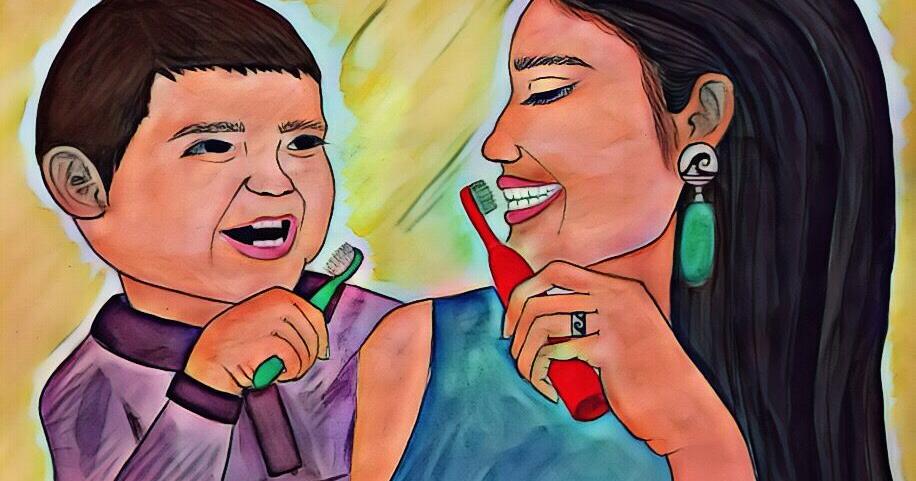New baby book in Hopi, Crow, aims to bring importance of oral hygiene to Native youth | Features

FLAGSTAFF, Ariz. — Decayed or missing teeth are four times more prevalent in American Indian children under the age of 6 than among white children, according to the National Institute of Dental and Craniofacial Research (NIDCR).
This alarming statistic is in part what sparked health and dental researchers at Northern Arizona University to make a baby and toddler book for Native parents and children, illustrated by Navajo-Hopi artist Bré Taylor with words in the Hopi and Crow language.
NIDCR funded the Great Beginnings for Healthy Native Smiles initiative which aims to address the oral healthcare inequity in Hopi tribal members in Arizona and Crow tribal members in Montana.
NAU’s Julie Baldwin, PhD, is the principal investigator of the initiative Baldwin assembled a research team comprised of key tribal healthcare providers, cultural experts and NAU faculty and staff, including NAU Department of Dental Hygiene assistant professor Heather Thomas.
Thomas had the idea to make the small baby and toddler book for parents to take home and read with their children. There are children’s books that center on dental care, but there are very few created for and by Native peoples, the group realized.
The team found it necessary to seek Hopi and Crow insight continuously, so that the book reflected cultural norms and correct language usage. Involving Hopi and Crow people like Stephanie Hyeoma, a community health representative for the Hopi Department of Health and Human Services, enabled Thomas to record an audiobook version to reach more parents and children. Hyeoma said that she applied for the health educator position to make a difference.
Taylor provided vibrant illustrations to reflect the Hopi people who are meant to read the book. The Crow version features Crow photos and visually engaging imagery. Many resources distributed by dentists and schools in Arizona are centered around white culture and miss key elements that are culturally relevant to Native peoples, NAU said. Without these elements helping them connect culturally to the resources, they may not be as impactful.
Within the pages
The Hopi book begins with welcoming baby earthside, with an illustration of a pregnant Hopi woman tending to her garden of corn.
As the pages turn, illustrations dance across the seam paired with Hopi translations of the life of a Hopi child.
An introduction to oral health begins on page nine, where simple, colorful images show how some of baby’s food turns into acid in their mouth and can then cause cavities if not properly cleaned.
A basic overview of key childhood dental hygiene is provided with vibrant illustrations to help solidify the suggestions. The book ends with the traditional practice of throwing the first lost tooth toward the sun and praying for strength for the new tooth that will replace the lost — a cultural difference from the typical American tooth fairy tradition.
Thomas has found through her research that interdisciplinary media and integrating health education into our everyday lives have stronger impacts than reports, pamphlets, or infographics. How people receive educational information plays a role in retention and implementation, and these books provide an entertaining, accessible and applicable resource for Hopi and Crow families.
NAU dental hygiene students head to Hopi
NAU dental hygiene students spend some of their clinical rotations working at Hopi Health Center, in collaboration with local dentists.
There are gaps in dental care for millions of American Indians, and NAU is dedicated to closing them by sustaining a symbiotic relationship between dental students and Hopi dental patients. Dental students gain applied experience and a deeper understanding of Hopi people that translates into their work as dental healthcare workers, and Hopi dental patients gain increased access to dental care.
While on clinical rotations, these students often bring along copies of “Welcome Baby, Smile!” to give to parents and children, aiding in dissemination of a powerful resource.
View the Hopi Welcome, Baby, Smile! eBook webpage for a downloadable eBook and a visualized audiobook narrated by Stephanie Hyeoma at bit.ly/welcomebabysmile.
View the Crow Welcome, Baby, Smile! eBook webpage for a downloadable eBook at https://welcomebabysmile.wixsite.com/website.
Information provided by NAU.
link




:max_bytes(150000):strip_icc()/asian-sick-little-girl-lying-in-bed-with-a-high-fever-952683074-5b5b784046e0fb005027ca13.jpg)


